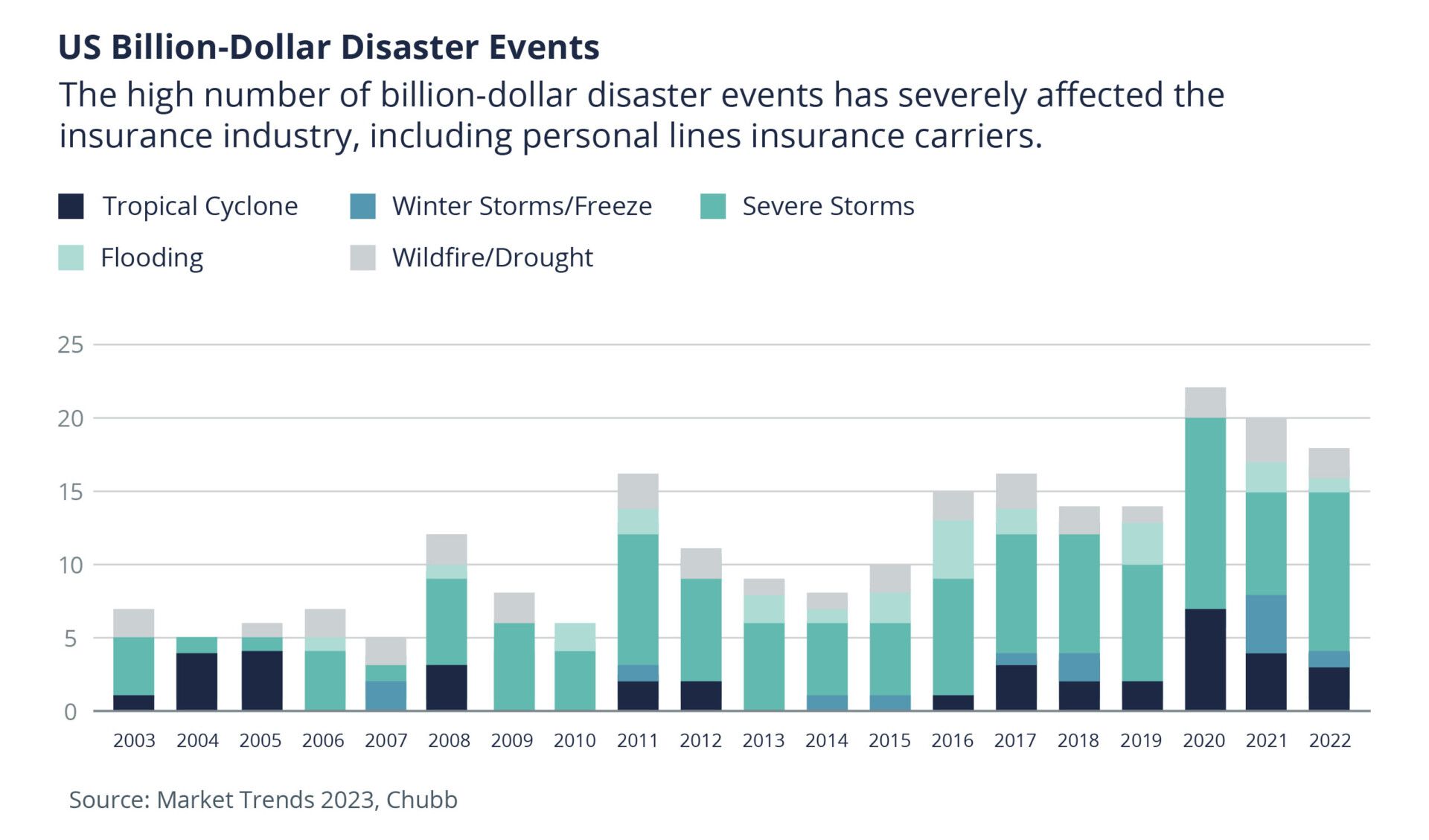Blog
California Affluent Personal Insurance for Homeowners: 2023 Market Outlook
Learn how to overcome common challenges that California homeowners are facing in the affluent personal insurance market.
It's a volatile time within the private client insurance market, and California homeowners are in a tough spot as we head further into 2023.
Specialized affluent market insurers in the state continue to struggle to offer affordable and comprehensive solutions to consumers who live in moderate to extreme wildfire areas. Some insureds who score high on wildfire exposures may find themselves forced to self-insure or place coverage with the state-funded FAIR Plan as a last resort. Additional causes of loss, such as flood and earthquake, both specialty policies, are being scrutinized as well.
Across the US, 2022 ranked as the third-highest overall billion-dollar catastrophic loss on record. While the number of wildfires in California showed a decline from the previous five-year average, there were other major losses, such as flooding, that impacted the state overall. These factors have made it more difficult for affluent homeowners to obtain insurance with favorable conditions.

7 Factors Affecting the California Affluent Personal Insurance Market
The rise in catastrophic losses isn't the only thing leading to a difficult affluent personal insurance market—other contributions include changes within the insurance industry, state laws and programs, and the overall economy. The factors influencing the market in 2023 include:
- Increase in Reinsurance Rates: Reinsurance rates for affluent market carriers like Chubb, AIG, and PURE have jumped significantly over the past years. Most insurers rely on reinsurance to assume part of the risk they take, particularly for catastrophic coverages. Increasing reinsurance rates have led to carriers being more selective on what risk profiles fit their appetites, and they are charging more for those risks they wish to retain.
- Rate Inadequacy: Affluent market personal insurance companies continue to be rate inadequate in that the loss costs they are incurring exceed the premiums they are collecting. Challenges imposed by the California Department of Insurance (DOI) and restrictions of Proposition 103 have continued to further limit their ability to obtain rate filings approved in a timely manner.
- Direct Writers’ Limited Appetites: Major players in the direct writer segment have experienced record underwriting losses in 2021 and 2022. As a result, they are aggressively limiting appetites moving forward or declining to write in wildfire-prone areas they may have offered terms in the past.
- Inadequate "Last Resort" Option: The California FAIR Plan, which is a last-resort coverage option in California, is often inadequate for high-value homes. The Fair Plan is limited to a $3 million maximum dwelling replacement and only provides basic causes of loss coverage for fire, smoke, and explosion.
- Mandatory Earthquake Retrofitting: Earthquake underwriting appetites are shrinking, and premiums are skyrocketing due to the aggregation of risks and overall capacity concerns. Having homes that have been properly retrofitted or built to withstand earthquakes is becoming a mandatory compliance condition to provide coverage terms in the future.
- Loss Control Requirements: Underwriters are also implementing mandatory requirements around proactive loss control measures for the property. As prerequisites to offering terms, insurers may require measures that include replacing wood shake roofs with cementitious materials, installing water leak detection devices throughout the home, having specialized ember-resistant gutters and vents, and aggressively removing brush around the home.
- Building Costs, Inflation, and Supply Chain Disruptions: Replacement costs are rising due to soaring costs of construction, availability of product, and claims expenses jumping in auto and property lines.

New Trends in Surplus Lines Insurance Expand Options for Homeowners
While most standard market carriers are continuing to non-renew coverage and clamping down on offering terms, unique coverage solutions are beginning to emerge within the surplus lines non-admitted segments. Large multinational high-net-worth insurers are shifting increased focus around non-admitted lines solutions because they are less heavily regulated from a coverage design and rate perspective. This increased flexibility has fostered much-needed creativity around solutions for tough-to-place coverage situations in wildfire-prone areas.
For large property exposures, excess coverage strategies called “layering” are becoming more popular. Layering is a risk-sharing technique when a primary carrier takes on the first layer of coverage up to a specific total loss limit while partnering with additional carrier(s) on offering excess terms in a tower—each one in excess of lower limits written by other insurers. This approach of sharing in the loss can help to diminish the chances of a localized catastrophic loss severely impacting any single carrier. Having multiple insurers participate in a piece of the action can also lessen underwriting capacity concerns and potentially open new opportunities to write coverage in tough-to-place geographic areas.
With non-standard placements, there are sometimes major exclusions and ultimately more risk being shifted back to the consumer. For example, surplus lines policies often include significant wildfire-specific deductibles, major limitations on additional living expenses, capping of defense costs, and other limitations. Additionally, the state division of insurance is not obligated to step in and pay claims (as they are in standard markets) if a non-admitted carrier goes insolvent due to a major loss event.
Best Practices for Marketing Your Risk to Underwriters
As homeowners’ rates continue to jump and carrier appetites continue to decline, the number of applicants seeking new insurance options have skyrocketed. California underwriters who continue to write new business are significantly overwhelmed and often understaffed for the demands they are facing. There are limited specialty carriers that serve the highly affluent market in California, and new submissions are reaching record levels with those that still have capacity to write the business. A specialty underwriter may see upwards of several hundred applications in a single day coming across their desks. Because of these adverse conditions, the underwriting process is lengthy and complicated for the consumer, and they will often receive terms at the last minute.
If you are seeking private client insurance, here are some ways to ease the process of getting coverage:
- For complex risks, property values of more than $10 million for a single location, or when there are multiple homes or locations in a portfolio, kick off the overall insurance renewal process approximately 90 days in advance.
- Underwriters often request specific information after the submission has been made. They may need to conduct a loss control visit to the property. Be prepared—multiple underwriting requests for additional information are customary, and providing comprehensive answers in a timely fashion improves the situation.
- Proactively include specifics on any loss prevention measures undertaken on the risk in recent years. These may include installing ember-resistant vents and gutters, removing brush and other fuels from around the foundation, installing fire suppression devices in the home, and completing earthquake retrofitting and fire-resistant roof replacements.
- Provide recent appraisals, photos, certificates, and surveys that describe the upgraded elements of your home.
More valuables to protect often means more complexity when it comes to insurance. As catastrophic events rise, however, it's increasingly important to ensure your home is shielded in the case of a major loss. Being prepared, following the critical steps above, and being proactive can spell the difference between your insurance submissions getting the attention they deserve and sitting at the bottom of the stack.
Knowing your insurance options and the steps needed for coverage and renewal can lead to a smoother insurance process. Reach out to your Woodruff Sawyer account executive to learn more about obtaining a favorable California affluent personal insurance policy.
Table of Contents







